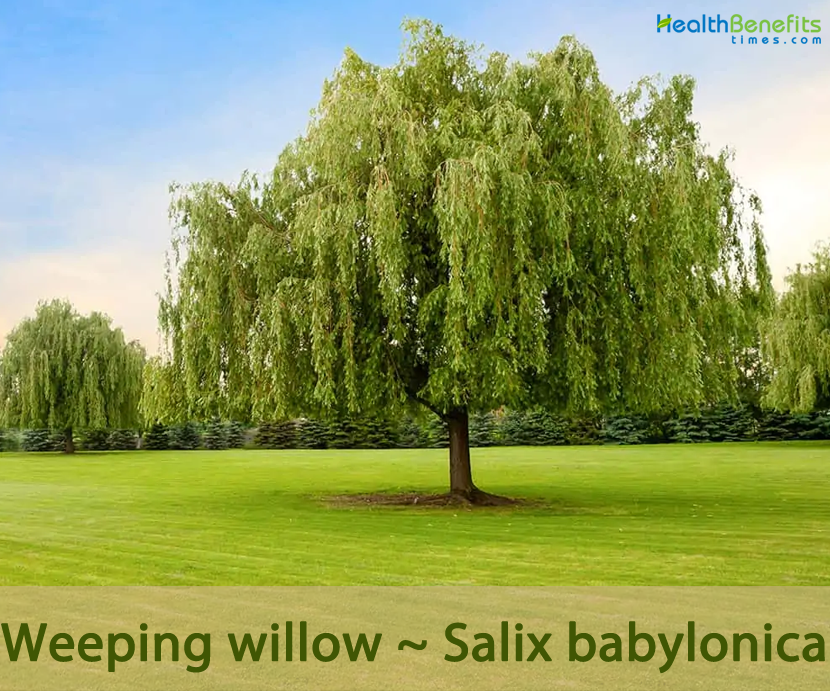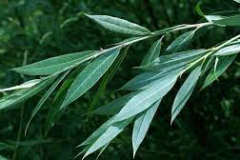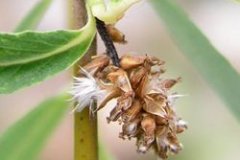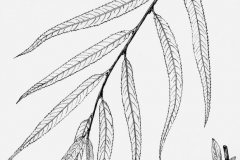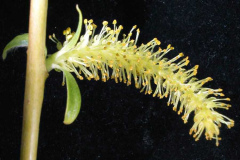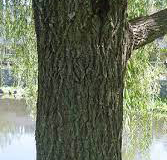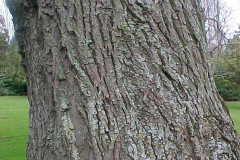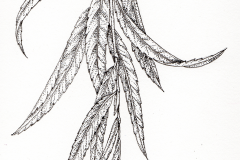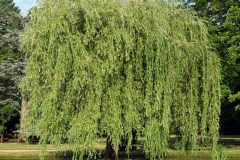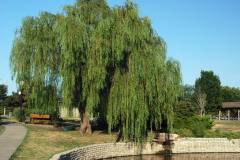| Weeping willow Quick Facts | |
|---|---|
| Name: | Weeping willow |
| Scientific Name: | Salix babylonica |
| Origin | Northern China, but cultivated for millennia elsewhere in Asia, being traded along the Silk Road to southwest Asia and Europe |
| Colors | Initially green and turns yellowish-brown when ripened |
| Shapes | Dry, hard, 3-4 mm long capsule |
| Health benefits | Support for abscesses, carbuncle, fever, rheumatoid arthritis, skin diseases, ulcers, diarrhea, foul sores, hemorrhages, jaundice, headaches, neuralgia, joint pains, menstrual cramps and ankylosing spondylitis |
| Name | Weeping willow |
|---|---|
| Scientific Name | Salix babylonica |
| Native | Dry areas of northern China, but cultivated for millennia elsewhere in Asia, being traded along the Silk Road to southwest Asia and Europe. It is widely naturalized in southern and eastern Australia (i.e. in southern and central Queensland, eastern and southern New South Wales, the ACT, Victoria, Tasmania, south-eastern and eastern South Australia, and near Perth in south-western Western Australia). It is also widely naturalized overseas in Europe, southern Africa, New Zealand and the USA |
| Common Names | Weeping willow, Babylon Weeping Willow, Peking Willow, Chinese Weeping Willow, Chinese willow, mourning willow |
| Name in Other Languages | Afrikaans: Huil wilger, Treurwilger Albanian: Shelgje të qara, shelg, Shelgu pikëllues Amharic: Yemīyalek’isi wīlowi (የሚያለቅስ ዊሎው) Arabic: Shajarat alsifasaf (شجرة الصفصاف), Safsaaf baky (صفصاف باكي ) Aragonese: Sauce llorôn Armenian: Lats’ ktor (լաց կտոր), urreni babelonakan (ուռենի բաբելոնական) Azerbaijani: Ağlayan söyüd, Ağlar söyüd Basque: Zuain nigargille, zume negarti Belarusian: Viarba plakučaja (Вярба плакучая) Bengali: Kām̐dē u ilō (কাঁদে উইলো), Bēbilana u’ilō (বেবিলন উইলো) Bulgarian: Placheshta vŭrba (плачеща върба), placheshta vŭrba (плачеща върба) Burmese: Moemahk pain (မိုးမခပင်) Catalan: Desmai Chinese: Chuíliǔ (垂柳), hàn liǔ (旱柳) Croatian: Zalosna vrba Czech: Smuteční vrba, vrba babylónská, vrba Matsudova, vrba pekingská Danish: Grædende pil, Tåre-pil Dutch: Treurwilg English: Weeping willow, Babylon Weeping Willow, Peking Willow, Chinese Weeping Willow, Chinese willow, mourning willow Esperanto: Ploranta saliko Estonian: Nutt paju Filipino: Umiiyak na willow Finnish: Itkuraita, itkusalava, Itkupaju French: Saule pleureur, Sauce lloron, Saule de Babylone, Saule pleureur à bois vert, Saule pleureur, Vrai saule pleureur, saule de Babylone, saule parasol, saule tortueux Galician: Salgueiro chorón Georgian: T’irili (ტირილი ტირიფი), dzets’na (ძეწნა) German: Trauerweide, Babylon-Trauer-Weide, Trauer-Weide, chinesische Baumweide, chinesische Hängeweide, chinesische Weide, echte Trauerweide, Korkenzieher-Weide, Napoleons-Weide, Pekingweide, Pekingweide, Tränenweide, Greek: Itiá (ιτιά) Gujarati: Raḍatā vilō (રડતા વિલો) Hausa: Kuka Willow Hebrew: ערבה בוכה Hindi: Badamajanoon (बदमजनूं), Bahda, Majnu, Majunun Hungarian: Szomorúfűz, babiloni szomorúfűz, spirálfűz Icelandic: Grátandi víði, Grátvíðir Indonesian: Menangis willow Irish: Ag gol saileach, Saileach shilte Italian: Salice piangente, salice di Pechino, salice babilonese, Japanese: Shidareyanagi (シダレヤナギ), Ito yanagi (イトヤナギ), Shidare yanagi (シダレヤナギ), Unru~yuuyanagi (ウンルュウヤナギ) Javanese: Tangis Kannada: Aḷuvudu vilō (ಅಳುವುದು ವಿಲೋ) Kazakh: Jilap tal (жылап тал) Korean: Su yangbeodeul (수 양버들), Su yang beo deul (수양버들) Kurdish: Willough qirîn Lao: Honghai willow (ຮ້ອງໄຫ້ willow) Latin: Populus flere Latvian: Raudošs vītols Lithuanian: Verkiantis gluosnis, Svyruoklinis gluosnis Macedonian: Plačenje vrba (плачење врба), žalna vrba (жална врба) Malagasy: Ranomaso mitomany Malay: Wain willow Malayalam: Karayunna villēā (കരയുന്ന വില്ലോ) Maltese: Zafżaħ li jibki Marathi: Vilaap vilo (विलाप विलो), गिऊर Gioor Mongolian: Burgas uilj baina (бургас уйлж байна) Nepali: Rum̐dai vilō (रुँदै विलो), Bainśa (बैंश) Norwegian: Gråtende selje, Tårepil Oriya: କାନ୍ଦିବା Pashto: ژړا Persian: بید مجنون, درخت بید مجنون Polish: Wierzba płacząca, wierzba babilońska Portuguese: Salgueiro-chorão, Chorão, Chorão-da-babilônia, Salgueiro, Salgueiro-chorão, Vimeiro-chorão, Chorão-salgueiro (Brazil), Salceiro-da-Babilônia, vimeiro-do-Japão Punjabi: Rōṇā vilō (ਰੋਣਾ ਵਿਲੋ) Romanian: Salcie plângătoare, Salcie pletoasă Russian: Plakuchaya iva (плакучая ива), Iva plakuchaia (Ива плакучая), Iva vavilonskaia (Ива вавилонская) Sardinian: Salighe Serbian: Zalosna vrba (жалосна врба) Sindhi: روئندڙ بيد Sinhala: Hæ ep īma vilō (හැ ep ීම විලෝ) Slovak: Vŕba babylonská Slovenian: Jokajoča vrba, Vrba žalujka Spanish: Sauce, Sauce llorón, Sauce de Babilonia, Sauce llorón, juncia, llorón, sauce de Matsuda Sundanese: Nangis deet Swahili: Msafsafi wa Babeli Swedish: Tårpil Tajik: Girjai ʙed (гиряи бед) Tamil: Aḻukiṟa villō (அழுகிற வில்லோ) Telugu: Ēḍupu villō (ఏడుపు విల్లో), Arruppaalai, Attuppalai Thai: Wil low̒ r̂xngh̄ị̂ (วิลโลว์ร้องไห้), H̄liw (หลิว) Tongan: Hakoloa ani uilow, hakoloaʻani Turkish: Salkım Söğüt Ukrainian: Plakucha verba (плакуча верба), verba vavilonsʹka (верба вавілонська), Verba plakucha (Верба плакуча) Upper Sorbian: Wisata wjerba Urdu: روتے ہوئے ولو Uzbek: Yig’layotgan tol Vietnamese: Khóc liễu Welsh: Wylofain helyg, Helygen frau wylofus Zulu: Ekhala emawolini |
| Plant Growth Habit | Medium- to large-sized, rounded, deciduous landscape tree |
| Growing Climates | Shrub land, riparian habitats, freshwater wetlands, beside lakes, ponds, rivers, streams, in parks, maintained gardens and larger domestic gardens |
| Soil | Tolerant of many soil types, including alkaline, loamy, sandy, and clay soils. However, their preference is for moist, well-draining, slightly acidic soils. If your soil is too alkaline, you can make it more acidic by amending it with sulfur. It rarely thrives on chalk |
| Plant Size | Grows around 10 – 12 meters tall., occasionally reaching 18 meters |
| Bark | Grayish-brown or grayish-black bark with irregular furrows. |
| Leaf | Leaves are linear, lanceolate, light green on the upper surface, and glaucous or grayish-green beneath |
| Flowering season | April to May |
| Flower | Flowers are male and female green catkins that are about 1 to 2 inches long. They appear on separate male and female trees |
| Fruit Shape & Size | Dry green to a brown capsule that releases cottony-like seeds |
| Fruit Color | Initially green and turns yellowish-brown when ripened |
| Propagation | By seed, cuttings, layering |
| Plant Parts Used | Bark, leaves, seed, gum |
| Lifespan | Between 40 and 75 years |
| Season | Late May to early June |
Plant Description
Weeping willow is a medium to large-sized, rounded, deciduous landscape tree with a stout trunk topped by a graceful broad-rounded crown of branches that sweep downward to the ground. The tree normally grows around 10 – 12 meters tall, occasionally reaching 18 meters. The short bole can be quite thick. It grows rapidly, but has a short lifespan, between 40 and 75 years. The plant is found growing in shrub land, riparian habitats, and fresh water wetlands, beside lakes, ponds, rivers, streams, in parks, maintained gardens and larger domestic gardens. The plant is tolerant of many soil types, including alkaline, loamy, sandy, and clay soils. However, their preference is for moist, well-draining, slightly acidic soils. If your soil is too alkaline, you can make it more acidic by amending it with sulfur. It rarely thrives on chalk.
Many consider this tree to have the best form of the weeping willows available in commerce. Bark is gray-brown or gray-black with irregular furrows. Branchlets are typically green or brown. This weeping willow can be a spectacular specimen at the edge of a pond with its branches gracefully weeping down to touch the water; however, it is often very difficult to site this tree in a residential landscape. Some experts believe that the true species no longer exists in the wild in China and that plants being sold today under the name S. babylonica are primarily hybrids or mistakenly identified similar species.
Stem
The stems are reddish to yellowish brown and smooth. The nodes are rounded, hairy, and point downward. The wood is weak and susceptible to breakage and litter.
Leaves
Weeping willow has yellowish-brown shoots, with small buds. Smooth, hairless leaves are alternate, simple, and linear-lanceolate with an acuminate apex. They are 9-16 cm long and 0.5-1.5 cm wide, acuminate, cuneate, and have finely serrated margins. The leaves are light green above, and grayish-green or glaucous beneath. In autumn, the leaves turn golden-yellow. They are glabrous, and the stipules are slender. The fall foliage is greenish-yellow or sometimes golden yellow. The leaf margin is finely toothed. Leaves are spirally arranged along the branches. Leaf stalk is 5-10 mm long and pubescent.
| Leaf arrangement | Alternate |
| Leaf type | Simple |
| Leaf margin | Serrate; serrulate |
| Leaf shape | Lanceolate; linear |
| Leaf venation | Pinnate |
| Leaf type and persistence | Deciduous |
| Leaf blade length | 3 to 6 inches |
| Leaf color | Green on top, gray green underneath |
| Fall color | Yellow |
| Fall characteristic | Showy |
Flower
Plant is dioecious with Male and female flowers appearing in silvery green catkins born on separate male and female trees. Male catkin is 1.8-3 cm long and 0.5-1 cm wide while female catkin 1.5-2.5 cm long and 0.5 cm wide. They are silvery-green, non-showy, and appear from April to May. The male catkin is the showiest with only stamens, no petals, and measures 1 to 2 inches long. Flowers richness in nectar attracts an abundance of insects.
| Flower color | Greenish yellow |
| Flower characteristics | Inconspicuous and not showy; spring flowering; emerges in clusters on 1″ long catkins |
| Flowering | Spring |
Fruit
Fertile flowers are followed by dry, hard, 3-4 mm long capsule. It is initially green and turns yellowish-brown when ripened. Mature capsule releases many tiny, down-covered, or cottony seeds. It does not attract wildlife. They are not showy and create litter. They ripen in late May to early June.
| Fruit length | 1 inch |
| Fruit covering | Dry or hard; capsule |
| Fruit color | Green, turns brown when ripe |
| Fruit characteristics | Does not attract wildlife; inconspicuous and not showy; fruit, twigs, or foliage cause significant litter |
| Fruiting | Late spring and early summer |
History
Historically, weeping willow was used as a popular trading item along the Silk Road. It was introduced to England from Syria in 1730. It was first described and assigned its scientific name by the Swedish botanist and plant pathologist, Carl Linnaeus, in 1736. Linnaeus named weeping willow salix babylonica after mistaking it for the trees described growing along the rivers of Babylon in the Bible. The trees mentioned in the Bible were likely poplars, which are members of the willow family (Salicaceae). The species that Linnaeus observed was the variety that had been introduced into the Clifford Garden in Harte Kamp in the Netherlands.
Traditional uses and benefits of Weeping willow
- The leaves and bark are anti-rheumatic, astringent and tonic.
- Decoction of the leaves is used in the treatment of abscesses, carbuncle, fever, rheumatism, skin diseases, ulcers etc.
- An infusion of the bark has been used to treat diarrhea and fevers.
- The bark can be used as a poultice.
- Stem bark is used in the treatment of skin eruptions due to parasites.
- Root bark is used in a bath for the treatment of parasitic skin diseases.
- Gum from the stems is used in the treatment of foul sores.
- The down of the seeds is used in the treatment of fevers, hemorrhages, jaundice, rheumatism etc.
- The Chinese use the bark to treat fever and rheumatoid arthritis.
- Bark consists of salicylic acid which is the key ingredient of aspirin.
- It is useful in the treatment of various conditions including headaches, neuralgia and joint pains.
- Bark of the tree is used for joint pain, fevers, jaundice, menstrual cramps, rheumatoid arthritis (RA), osteoarthritis, gout, and a disease of the spine called ankylosing spondylitis.
- It is used to treat mastitis, toothaches, and scalds.
- The leaves have been used in treating fevers, skin eruptions, and to purify the blood.
- Native Americans used twigs and bark for medicine.
- They were chewed to relieve headaches.
- It can treat articular bleeding, heartburn, and stomach ailments.
- In the past people chewed bark of the willow tree to treat fever, inflammation and pain.
- The young twigs and bark were chewed to ease headache pain.
Culinary Uses
- Inner bark can be consumed raw or cooked.
- It can be dried, ground into a powder and then added to cereal flour for use in making bread etc.
- It has a very bitter flavor, it is a famine food that is only used when all else fails.
- Young shoots and flower buds can be consumed after cooking.
- Older leaves are used to adulterate tea.
- It is a source of a manna-like substance.
Other Facts
- Weeping willow is a popular ornamental tree in northern China, and is also grown for wood production and shelterbelts there, being particularly important around the oases of the Gobi Desert, protecting agricultural land from desert winds.
- Stems are very flexible and are used in basket making.
- The plant is usually coppiced annually when grown for basket making, though it is possible to coppice it every two years if thick poles are required as uprights.
- The extensive root system makes this species useful for binding soils.
- Decoction or infusion of the bark has been used as a wash to make the hair grow.
- It is sometimes used for erosion control, because it has a well-developed root system.
- The plant is used in reforestation projects.
- The plant is traditionally grown in living fences in the northwestern Himalayas, where it helps to exclude livestock and other animals; mark out land boundaries; whilst also providing a range of medicinal and other uses.
- The wood is used as a timber.
- The wood is also used for fuel.
- It can also be used for instrument making, such as flutes.
- Native Americans used the branches to make paintbrushes.
- Their wood is used to make products like cricket bats, flutes, furniture, boxes, broom handles, whistles, and fish traps.
- In Greece it was a common practice to place willow branches in the bed of a fertile woman with the belief that it would entice the magical serpents to impregnate her.
- Certain Native American tribes would place willow tree branches in the bed of newly-married couples with the faith that it would increase the chances of the woman bearing a child.
- The witches broom was supposed to have been made from the twigs of the willow tree.
- Willow trees are used in the manufacture of baskets, fishing nets, furniture and toys.
- Dyes extracted from willow trees are used for tanning of the leather.
- The commonest cultivated ‘weeping willow’ first introduced to Britain from a German nursery in about 1908.
Various Products
- Fodder: The leaves and tender shoots are used as fodder for cows and goats in some areas. The fodder compares favorably with lucerne. In a survey carried out in Bumthang district, Bhutan, in 1982, Salix babylonica was found to be among the preferred fodder trees by farmers.
- Apiculture: The flowers are a good source of honey.
- Fuel: Wood and branches of S. babylonica were traditionally used for fuel wood in China.
- Fiber: S. babylonica is a source of pulpwood and produces good quality newsprint paper also used for wrapping papers and high grade Kraft paper. Branches are used for basket making.
- Timber: Weeping willow wood is usually reddish-brown, light and soft, with a straight grain, and of moderate density. It is widely used for furniture, packing cases, agricultural tools, fiber board, plywood and mine poles
- Medicine: Leaves and bark have astringent and tonic properties. Catkins and young twigs are antipyretic. Leaf infusion is given to rheumatics.
Different Services
- Erosion control: Planting the tree along riverbanks prevents soil and water erosion, wave-shock and minimizes sediment deposition. In New Zealand, willows are widely grown for soil conservation purposes, where they are the most abundant exortic species after Pinus radiata.
- Shade or shelter: Weeping willow is an important tree species for farmland shelterbelts.
- Ornamental: S. babylonica is also valuable as an ornamental garden and park tree. The male is mainly the one planted for ornamental purposes.
- Pollution control: It tolerates high levels of sulfur dioxide.
Management Info
Commonly used management techniques include mechanical control (e.g. felling, excavating) and/or herbicides, e.g. glyphosphate, picloram, picloram/triclopyr. Herbicides can be applied by foliar spray, stem injection, and cut stump application. Repsrouting may occur.
The Willows National Management Guide: Current management and control options for Willow (Salix spp) in Australia is divided into six sections that includes detailed information on the spread and impacts of willows on riparian habitats, guidelines for how to plan a willow management program, including when to prioritize, detailed descriptions of available control and waste management methods, including when to use specific methods. The manual also includes important information on how to sustain the program in order to endure long term benefits, monitoring, managing erosion, re-vegetation and case studies of different methods, approaches and strategies in management.
The Weed Control Methods Handbook provides you with detailed information about the tools and techniques available for controlling invasive plants, or weeds, in natural areas. This Handbook is divided into eight chapters, covering a range of different control methods: manual, mechanical, promoting competition from native plants, grazing, bio-control, herbicides, prescribed fire, solarization, flooding, and other, more novel, techniques. Each control method has advantages and disadvantages in terms of its effects against the target weed(s), impacts to untargeted plants and animals, risks to human health and safety, and costs.
References:
https://en.wikipedia.org/wiki/Salix_babylonica
https://www.itis.gov/servlet/SingleRpt/SingleRpt?search_topic=TSN&search_value=837788#null
http://www.hear.org/pier/species/salix_babylonica.htm
https://pfaf.org/user/Plant.aspx?LatinName=Salix+babylonica
https://www.missouribotanicalgarden.org/PlantFinder/PlantFinderDetails.aspx?kempercode=c148
http://www.theplantlist.org/tpl1.1/record/kew-5004552
https://indiabiodiversity.org/species/show/266643
https://gd.eppo.int/taxon/SAXBA
https://temperate.theferns.info/plant/Salix+babylonica
https://plants.usda.gov/home/plantProfile?symbol=SABA


